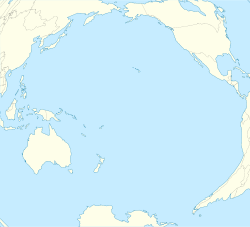Derwent Hunter Guyot
Appearance
| Derwent Hunter Guyot | |
|---|---|
| Summit depth | 323 metres (1,060 ft)[1] |
| Location | |
| Location | To the east of the coast of New South Wales, Australia |
| Group | Tasmantid Seamount Chain |
| Coordinates | 30°51′57″S 156°11′21″E / 30.86583°S 156.18917°E |
| Geology | |
| Type | Guyot |
| History | |
| Discovery date | Named from the Australian schooner "Derwent Hunter" that discovered it in 1958[1] |
The Derwent Hunter Guyot is an extinct volcanic seamount of the Tasmantid Seamount Chain.

It is a basaltic volcano that erupted between 12,400,000 and 15,400,000 years ago,[2] with survey data that indicates it rises about 4,000 m (13,000 ft) above the local sea floor to a minimum depth of 323 m (1,060 ft).[1] The sediments deposited on top of the alkali olivine basalt[2] originate from the early Middle Miocene.[3] The Derwent Hunter Guyot appears to be double peaked.[4] It was discovered in 1958[1] and described as a seamount in 1961.[5]
The waters above it are incorporated in the Central Eastern Marine Park, an Australian marine park.[6]
References
[edit]- ^ a b c d "GEBCO Undersea Feature Names Gazetteer".
- ^ a b Eggins, S. M.; Green, David Headley; Falloon, Trevor J. (1991). "The Tasmantid seamounts: Shallow melting and contamination of an EM1 mantle plume". Earth and Planetary Science Letters. 107 (3–4): 448–462. Bibcode:1991E&PSL.107..448E. doi:10.1016/0012-821X(91)90092-V.
- ^ Quilty, Patrick G. (1993). "Tasmantid and Lord Howe seamounts: biostratigraphy and palaeoceanographic significance". Alcheringa: An Australasian Journal of Palaeontology. 17 (1): 27–53. Bibcode:1993Alch...17...27Q. doi:10.1080/03115519308619487.
- ^ van der Linden, Willem JM (1970). "Morphology of the Tasman Sea floor". New Zealand Journal of Geology and Geophysics. 13 (1): 282–91. Bibcode:1970NZJGG..13..282V. doi:10.1080/00288306.1970.10428218.
- ^ Standard, J. C. (1961). "Submarine Geology of the Tasman Sea". Geological Society of America Bulletin. 72 (12): 1777–1788. doi:10.1130/0016-7606(1961)72[1777:SGOTTS]2.0.CO;2.
- ^ "Temperate East Marine Parks Network Management Plan 2018" (PDF). Parks Australia. Retrieved August 16, 2018.

